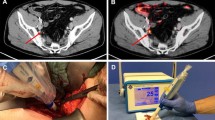Abstract
Prostate Specific Membrane Antigen Positron Emission Tomography/Computed Tomography (PSMA-PET/CT) has increased the sensitivity and specificity of imaging to identify metastatic prostate cancer in the group of patients with early biochemical recurrence when compared to conventional imaging. In patients who develop biochemical recurrence of prostate cancer following surgical resection, salvage lymph node dissection may reduce prostate specific antigen (PSA) levels and delay the time for commencement of systemic therapies. However, PLND may be an anatomically and technically difficult procedure, particularly with small metastatic diseases which can be problematic for intra-operative identification. We describe the technique using PSMA-PET imaging to pre-operatively localise areas of low-volume nodal metastatic disease with hookwire to allow targeted lymph node dissection with direct visualisation and palpation to ensure adequate clearance of involved nodes.



Similar content being viewed by others
Abbreviations
- BCR:
-
Biochemical recurrence
- CT:
-
Computed tomography
- LND:
-
Lymph node dissection
- PET:
-
Positron emission tomography
- PSA:
-
Prostate specific antigen
- PSMA:
-
Prostate specific membrane antigen
References
Simmons MN, Stephenson AJ, Klein EA (2007) Natural history of biochemical recurrence after radical prostatectomy: risk assessment for secondary therapy. Eur Urol 51(5):1175–1184. https://doi.org/10.1016/j.eururo.2007.01.015
Abdollah F, Briganti A, Montorsi F, Stenzl A, Stief C, Tombal B, Van Poppel H, Touijer K (2015) Contemporary role of salvage lymphadenectomy in patients with recurrence following radical prostatectomy. Eur Urol 67(5):839–849. https://doi.org/10.1016/j.eururo.2014.03.019
Perera M, Papa N, Christidis D, Wetherell D, Hofman MS, Murphy DG, Bolton D, Lawrentschuk N (2016) Sensitivity, specificity, and predictors of positive 68 ga-prostate-specific membrane antigen positron emission tomography in advanced prostate cancer: a systematic review and meta-analysis. Eur Urol. https://doi.org/10.1016/j.eururo.2016.06.021
Yaxley JWD, Delahunt B, Egevad L, Srigley J, Samaratunga H (2018) Reconsidering the role of pelvic lymph node dissection with radical prostatectomy for prostate cancer in an era of improving radiological staging techniques. World J Urol 36:15–20
Rauscher I, Duwel C, Wirtz M, Schottelius M, Wester HJ, Schwamborn K, Haller B, Schwaiger M, Gschwend JE, Eiber M, Maurer T (2016) Value of 111 In-PSMA-radioguided surgery for salvage lymphadenectomy in recurrent prostate cancer: correlation with histopathology and clinical follow-up. BJU Int. https://doi.org/10.1111/bju.13713
Rauscher I, Eiber M, Gschwend JE, Maurer T (2018) Novel technology of molecular radio-guidance for lymph node dissection in recurrent prostate cancer by PSMA-ligands. World J Urol Accept publication. https://doi.org/10.1007/s00345-018-2200-3
Allaf ME, Palapattu GS, Trock BJ, Carter HB, Walsh PC (2004) Anatomical extent of lymph node dissection: impact on men with clinically localized prostate cancer. The J urol 172(5 Pt 1):1840–1844
Heidenreich A, Varga Z, Von Knobloch R (2002) Extended pelvic lymphadenectomy in patients undergoing radical prostatectomy: high incidence of lymph node metastasis. The J urol 167(4):1681–1686
Bader P, Burkhard FC, Markwalder R, Studer UE (2003) Disease progression and survival of patients with positive lymph nodes after radical prostatectomy. Is there a chance of cure? The J urol 169(3):849–854. https://doi.org/10.1097/01.ju.0000049032.38743.c7
Campbell SC, Klein EA, Levin HS, Piedmonte MR (1995) Open pelvic lymph node dissection for prostate cancer: a reassessment. Urology 46(3):352–355. https://doi.org/10.1016/S0090-4295(99)80219-2
Clark T, Parekh DJ, Cookson MS, Chang SS, Smith ER Jr, Wells N, Smith J Jr (2003) Randomized prospective evaluation of extended versus limited lymph node dissection in patients with clinically localized prostate cancer. The J urol 169(1):145–147
Kavoussi LR, Sosa E, Chandhoke P, Chodak G, Clayman RV, Hadley HR, Loughlin KR, Ruckle HC, Rukstalis D, Schuessler W et al (1993) Complications of laparoscopic pelvic lymph node dissection. The J urol 149(2):322–325
Stone NN, Stock RG, Unger P (1997) Laparoscopic pelvic lymph node dissection for prostate cancer: comparison of the extended and modified techniques. The J urol 158(5):1891–1894
Raboy A, Adler H, Albert P (1997) Extraperitoneal endoscopic pelvic lymph node dissection: a review of 125 patients. The J urol 158(6):2202–2204
Herrell SD, Trachtenberg J, Theodorescu D (1997) Staging pelvic lymphadenectomy for localized carcinoma of the prostate: a comparison of 3 surgical techniques. The J urol 157(4):1337–1339
Klein EA, Kattan M, Stephenson A, Vickers A (2008) How many lymphadenectomies does it take to cure one patient? Eur Urol 53(1):13–15
Briganti A, Chun FK, Salonia A, Suardi N, Gallina A, Da Pozzo LF, Roscigno M, Zanni G, Valiquette L, Rigatti P, Montorsi F, Karakiewicz PI (2006) Complications and other surgical outcomes associated with extended pelvic lymphadenectomy in men with localized prostate cancer. Eur Urol 50(5):1006–1013. https://doi.org/10.1016/j.eururo.2006.08.015
Musch M, Klevecka V, Roggenbuck U, Kroepfl D (2008) Complications of pelvic lymphadenectomy in 1,380 patients undergoing radical retropubic prostatectomy between 1993 and 2006. The J urol 179(3):923–928
Demiral G, Senol M, Bayraktar B, Ozturk H, Celik Y, Boluk S (2016) Diagnostic value of hook wire localization technique for non-palpable breast lesions. J clin med Res 8(5):389–395. https://doi.org/10.14740/jocmr2498w
O’Kane DB, Lawrentschuk N, Bolton DM (2016) Prostate cancer nodal oligometastasis accurately assessed using prostate-specific membrane antigen positron emission tomography-computed tomography and confirmed histologically following robotic-assisted lymph node dissection. Urol Annal 8(2):255–257. https://doi.org/10.4103/0974-7796.179237
Author information
Authors and Affiliations
Contributions
E Clarebrough: Manuscript writing/editing, D Cristidis: Data collection or management, Manuscript writing/editing, C Duncan: Manuscript writing/editing, A Lavoipierre: Protocol/project development, Data collection or management, N Lawrentschuk: Protocol/project development, Data collection or management
Corresponding author
Ethics declarations
Conflict of interest
All of the authors declare that they have no conflict of interest.
Informed consent
The individual re-identifiable data included in this article were included with the informed consent of the patient.
Human and animal rights
This article does not contain any experimental studies with human participants or animals performed by any of the authors.
Additional information
Paper part of topic issue: Bolton Frydenberg—”Advances in Imaging in Met. Prost. Cancer”.
Rights and permissions
About this article
Cite this article
Clarebrough, E., Duncan, C., Christidis, D. et al. PSMA-PET guided hook-wire localization of nodal metastases in prostate cancer: a targeted approach. World J Urol 37, 1251–1254 (2019). https://doi.org/10.1007/s00345-018-2282-y
Received:
Accepted:
Published:
Issue Date:
DOI: https://doi.org/10.1007/s00345-018-2282-y




